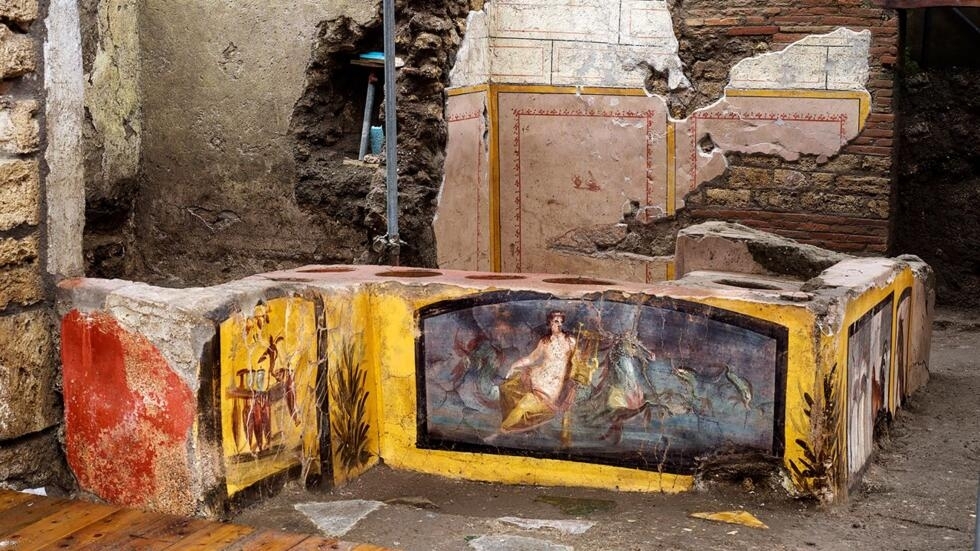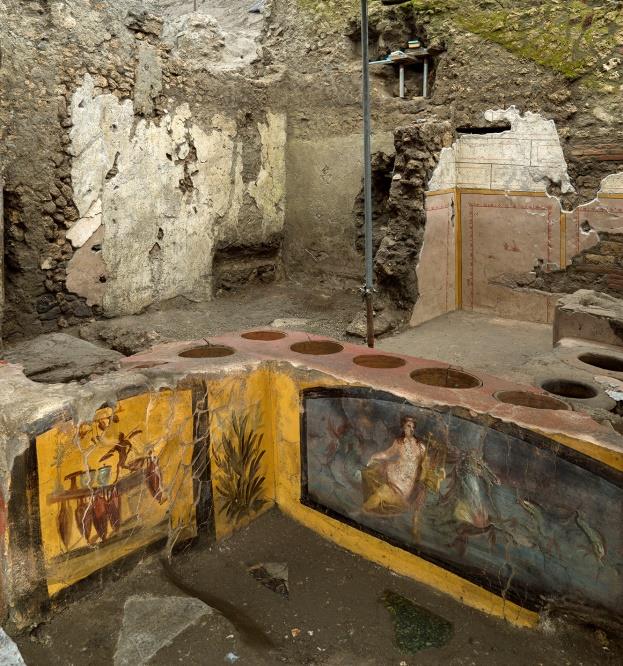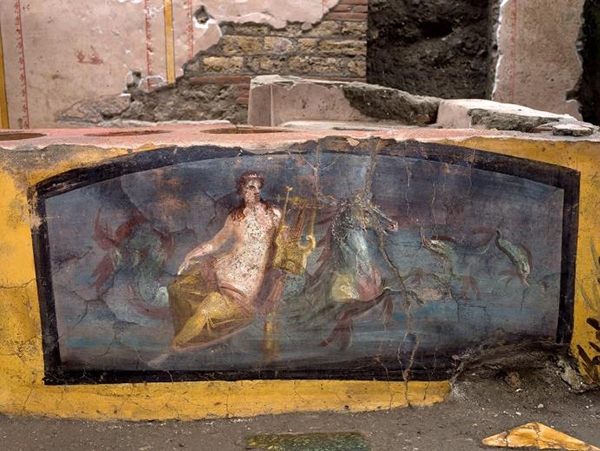Introduction
In the bustling heart of ancient Pompeii, a remarkable archaeological discovery has shed new light on the city’s vibrant food culture. In 2020, archaeologists announced the unearthing of the Thermopolium of Regio V, one of the oldest and most well-preserved “fast food” establishments ever found in the ancient world. This remarkable find offers a tantalizing glimpse into the lives of Pompeii’s working classes and their culinary habits, providing a fascinating window into the past.

The Thermopolium, which translates to “hot drinks counter,” was a type of ancient eatery where customers could purchase ready-to-eat meals and hot beverages. These establishments were popular among the working classes and those who could not afford the luxury of a private kitchen, offering a convenient and affordable alternative to home-cooked meals. By exploring the Thermopolium of Regio V, we can gain a deeper understanding of the social and culinary dynamics that shaped the lives of Pompeii’s residents over 2,000 years ago.
The Discovery of the Thermopolium
The Thermopolium of Regio V was discovered as part of the ongoing excavations in Pompeii, a city that has captivated the world with its remarkably well-preserved ruins. The site was first identified in 2019, and the subsequent excavation in 2020 revealed a wealth of fascinating details about this ancient fast food establishment.
One of the most striking features of the Thermopolium was its well-preserved counter, which was adorned with intricate frescoes and inlaid marble. This counter was designed to showcase the selection of ready-made dishes that were available to customers, each kept warm in individual terracotta pots that were set into the counter. The archaeologists were even able to identify the remains of a “paella-type dish” in one of these pots, which included a mixture of mammals, birds, fish, and snails – providing a tantalizing glimpse into the diverse culinary offerings of the Thermopolium.
In addition to the counter, the excavation also uncovered a well-preserved kitchen area, complete with cooking equipment and storage jars. This allowed the archaeologists to gain a deeper understanding of the food preparation and serving processes that took place within the Thermopolium.
The Significance of the Thermopolium
The discovery of the Thermopolium of Regio V is significant for several reasons. Firstly, it provides a rare and invaluable glimpse into the daily lives and culinary habits of Pompeii’s working classes. Unlike the lavish dining rooms and kitchens of the wealthy elite, the Thermopolium offers a window into the culinary experiences of the common people – those who relied on these fast food establishments for their daily sustenance.

Secondly, the Thermopolium sheds light on the social and economic dynamics of ancient Pompeii. These establishments were not just places to grab a quick meal; they were also hubs of social interaction, where people from all walks of life could come together and share a meal. The Thermopolium’s location within the bustling Regio V district, which was home to a diverse mix of artisans, merchants, and laborers, suggests that it catered to a wide range of customers and played a vital role in the community.
Moreover, the Thermopolium’s well-preserved state and the wealth of information it has yielded about ancient food preparation and serving practices make it an invaluable resource for scholars and historians. By studying the Thermopolium, researchers can gain a deeper understanding of the culinary traditions, cooking techniques, and dietary habits of the ancient Pompeians, which can shed light on the broader social and cultural dynamics of the Roman world.
The Culinary Offerings of the Thermopolium
One of the most fascinating aspects of the Thermopolium of Regio V is the insight it provides into the culinary offerings of these ancient fast food establishments. The discovery of the “paella-type dish” in one of the heated clay pots offers a tantalizing glimpse into the diverse and flavorful cuisine that was available to Pompeii’s working classes.
![The owner of this Pompeii fast food restaurant stashed his earnings in a jar, likely before running off (OC, info in comments) [5803x3869] : r/ArtefactPorn](https://archeology.dalatcamping.net/wp-content/uploads/2024/08/isu2lmqv35z81.jpg)
The dish, which included a mixture of mammals, birds, fish, and snails, suggests that the Thermopolium’s menu was not limited to simple or basic fare. Instead, the chefs of the Thermopolium were skilled in the preparation of complex and varied dishes, drawing on a wide range of local and regional ingredients to create meals that were both nutritious and delicious.
It’s worth noting that the discovery of this “paella-type dish” is particularly significant, as it challenges the common perception of ancient Roman cuisine as being primarily focused on staple foods like bread, porridge, and basic vegetable dishes. The Thermopolium’s menu, as evidenced by this remarkable find, indicates that the culinary horizons of ancient Pompeii were much broader and more sophisticated than previously thought.
The Role of the Thermopolium in Pompeii’s Social Fabric
Beyond its culinary significance, the Thermopolium of Regio V also provides valuable insights into the social and economic dynamics of ancient Pompeii. These establishments were not just places to grab a quick meal; they were also hubs of social interaction, where people from all walks of life could come together and share a meal.
The Thermopolium’s location within the bustling Regio V district, which was home to a diverse mix of artisans, merchants, and laborers, suggests that it catered to a wide range of customers. This diversity of patrons likely contributed to the Thermopolium’s vibrant atmosphere, where people from different backgrounds could mingle and exchange ideas, gossip, and news.
Moreover, the Thermopolium’s role as a gathering place for the working classes highlights the importance of these establishments in the social fabric of ancient Pompeii. For those who could not afford the luxury of a private kitchen, the Thermopolium provided a vital service, offering a convenient and affordable alternative to home-cooked meals. In this way, the Thermopolium served as a crucial hub of community life, where the city’s laborers, artisans, and merchants could come together and share a moment of respite and sustenance.
The Lasting Legacy of the Thermopolium
The discovery of the Thermopolium of Regio V has left a lasting impact on our understanding of ancient Pompeii and the culinary habits of its inhabitants. This remarkable find not only sheds light on the daily lives and eating habits of the city’s working classes but also challenges our preconceptions about the sophistication and diversity of ancient Roman cuisine.

By uncovering the secrets of the Thermopolium, archaeologists have provided a unique window into the past, allowing us to glimpse the vibrant food culture that once thrived in this ancient city. The detailed information gathered from this site, including the discovery of the “paella-type dish” and the well-preserved kitchen equipment, offers invaluable insights that can inform our understanding of the broader social, economic, and culinary dynamics of the Roman world.
As we continue to explore the ruins of Pompeii, the Thermopolium of Regio V stands as a testament to the enduring legacy of this remarkable city. It serves as a powerful reminder that even the most humble of establishments can hold the key to unlocking the secrets of the past, and that by studying the everyday lives of ancient people, we can gain a deeper appreciation for the richness and complexity of human history.
Conclusion
The discovery of the Thermopolium of Regio V in Pompeii has captivated the world, offering a rare and invaluable glimpse into the culinary and social fabric of ancient Roman life. This ancient fast food establishment, with its well-preserved counter, kitchen, and tantalizing clues about its menu, provides a fascinating window into the daily lives and eating habits of Pompeii’s working classes.
By exploring the Thermopolium, we can gain a deeper understanding of the social and economic dynamics that shaped the lives of Pompeii’s residents, as well as the remarkable sophistication and diversity of ancient Roman cuisine. This remarkable find serves as a testament to the enduring legacy of Pompeii, and the ongoing efforts of archaeologists to uncover the secrets of the past and share them with the world.
As we continue to delve into the rich history and culture of ancient Pompeii, the Thermopolium of Regio V will undoubtedly remain a source of fascination and inspiration, inspiring us to explore the stories and traditions that have shaped our world.

